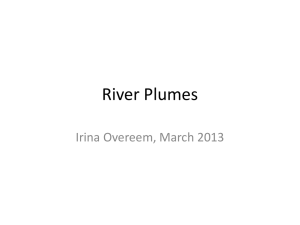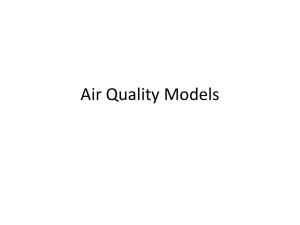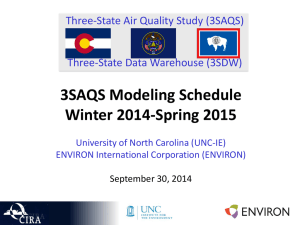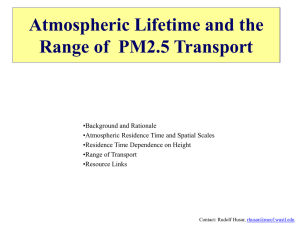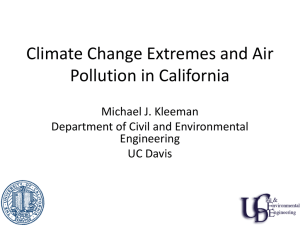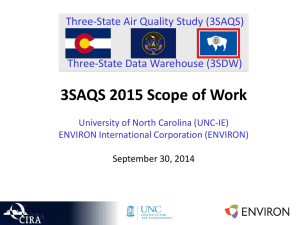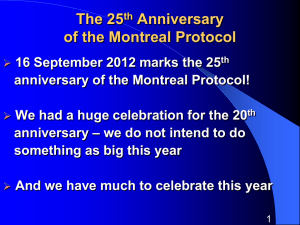Estimating Single Source Impacts on Secondary Pollutants
advertisement
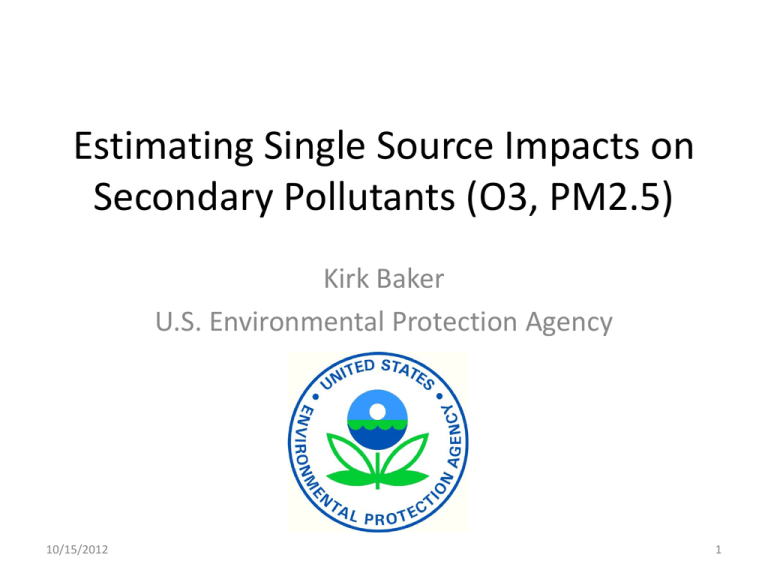
Estimating Single Source Impacts on Secondary Pollutants (O3, PM2.5) Kirk Baker U.S. Environmental Protection Agency 10/15/2012 1 Motivation for Estimating Single Source Secondary Impacts • New Source Review (NSR) and Prevention of Significant Deterioration (PSD) programs – Assess the air quality impacts of new or modified sources – EPA granted Sierra Club petition with commitment to update Appendix W to address O3 and secondary PM2.5 impacts – Interpollutant trading (NSR offset) provisions • National Environmental Policy Act (NEPA) – Assess the environmental impacts of new or modified sources • Title VI of 1964 Civil Rights Act – Complaints related to permits issued to facilities that receive Federal funding have disproportionate environmental impacts on certain communities 10/15/2012 2 What tools? • Air quality models exist to assess urban-scale impacts of primarily emitted pollutants from single sources for permit related purposes (AERMOD) • What tools are appropriate for estimating the impacts of secondarily formed pollutants (PM2.5 and ozone) from single sources on urban and regional scales? – Photochemical box models • OZIPR – Lagrangian models • CALPUFF • SCIPUFF/SCICHEM • HYSPLIT & FLEXPART – Photochemical transport models • CMAQ and CAMx • How are these different approaches are comparable and how best to apply models for permit modeling? • Tools must be able to be applied for a minimum of an entire year or ozone season 10/15/2012 3 Questions and Evaluation Challenges • How far away from a source are the highest impacts of primary and secondary PM2.5 and ozone? Does this change based on stack characteristics or co-emissions? • How well are near-field and long-range pollutant transport characterized by Lagrangian and Eulerian modeling systems? • How well do Eulerian and Lagrangian modeling systems characterize plume chemistry? • How well do Lagrangian modeling systems characterize the chemical and physical environment around the plume? 10/15/2012 4 Regional Inert Tracer Field Experiments • Inert tracer release experiments provide a useful independent evaluation of long range transport and dispersion algorithms – A known amount of tracer gas is released – Release characteristics are typically well known – Measured at downwind receptor sites • New EPA report details the evaluation of multiple LRT dispersion modeling systems using multiple tracer field studies: CALPUFF, SCIPUFF, HYSPLIT, FLEXPART, CAMx, and CALGRID – Draft final report “Documentation of CALPUFF and Other Long Range Transport Models using Tracer Test Experiment Data” http://www.epa.gov/ttn/scram/reports/EPA-454_R-12-003.pdf 10/15/2012 5 ETEX 1994 Observations (+36 hours) SCIPUFF CAMx Observations (+60 hours) SCIPUFF CAMx *Figures courtesy of ENVIRON 10/15/2012 6 Great Plains 1980 • Maximum field measurements of tracers shown at left for all monitors in the study and maximum model estimates (CAMx) at right) 10/15/2012 7 Using a chemical transport model (CTM) • Need to isolate the contribution/impacts of single sources – Source apportionment – Brute force emissions adjustment – HDDM • Need techniques or an approach for situations when sources and key receptors are in very close proximity (within the same grid cell or in neighboring grid cells) – Sub-grid plume treatment (CAMx PiG, CMAQ APT) – Nesting to finer grids 10/15/2012 8 Isolating Single Source Impacts in a CTM • Photochemical models used: CMAQ v.4.7.1 and CAMx v5.40 • Domains (34 layers): 36 km CONUS 12 4 km • 1999 hour specific CEM emissions for TVA Cumberland • 1999 hour specific biogenics estimated with BEIS model • 2001 NEI based anthropogenic emissions • Meteorological inputs generated using the WRF model version 3.3 10/15/2012 9 Similar spatial patterns of single source impacts using multiple models and techniques *red dot indicates source location 2 week (July 1999) episode maximum impact on NOX (NO+NO2) from source NOX 10/15/2012 10 Less consistency between model attribution approaches, evaluation with field measurements important Ozone tracking has not been implemented yet in CMAQ *red dot indicates source location 2 week (July 1999) episode maximum impact on ozone from source NOX 10/15/2012 11 2 week (July 1999) episode maximum impact on elemental carbon from source EC *red dot indicates source location Current version of CAMx (5.40) only includes DDM for gases 10/15/2012 12 2 week (July 1999) episode maximum impact on PM2.5 sulfate from source SOX *red dot indicates source location Current version of CAMx (5.40) only includes DDM for gases 10/15/2012 13 Source/Receptor Proximity Issues in CTM • Sub-grid plume treatment and sub-grid sampling provide information about source concentration at receptors within the same cell as the source • Plot shows PiG puffs using 2 different approaches to estimating wind shear impacts on the plume • The PiG plume continues to be far wider than aircraft measurements suggest. Plot courtesy of ENVIRON. Taken from Evaluation of Chemical Dispersion Models using Atmospheric Plume Measurements from Field Experiments, EPA Contract No: EP-D-07-102, WA No: 4-06 and 5-08 10/15/2012 14 Source/Receptor Proximity Issues in CTM • 200 m high-resolution grid sensitivitiy shown with color contours • While the standard PiG run tracks the centerline well, it is about six times wider than the high resolution plume. • The PiG puff width with all shearinduced growth removed matches the high resolution results better. • What is an appropriate configuration of sub-grid plume treatment for multi-year regulatory modeling applications? Plot courtesy of ENVIRON. Taken from Evaluation of Chemical Dispersion Models using Atmospheric Plume Measurements from Field Experiments, EPA Contract No: EP-D-07-102, WA No: 4-06 and 5-08 10/15/2012 15 Single Source Screening Level Tool Are screening level tools for single source estimates of secondary PM2.5 and ozone feasible? • A screening tool would ideally provide a quick, reasonable, credible, and appropriately conservative assessment of single source secondary impacts before more complex applications are required • ENVIRON presented a reduced form single source screening model that estimates ozone impacts from single source emissions of VOC and/or NOX based on CAMx-HDDM – http://www.epa.gov/ttn/scram/10thmodconf/presentations/2-21Morris_Ozone_Screen_New_Srcs_EPA_10th_AQMC_Mar_2012.pdf • OAQPS plans to explore this approach for ozone and PM2.5 to support single source NSR/PSD screening assessments • This modeling may provide some information for developing appropriate interpollutant trading ratios for PM2.5 10/15/2012 16 Future Directions • Evaluate single source models on a 1) theoretical fit for purpose basis and 2) operationally against field studies (or other innovate approaches) • Compromises may be necessary between approaches used to capture field measurements and multi-year regulatory modeling requirements • Need to identify credible “screening level” approach for single source secondary impacts on ozone and PM2.5 • Need to continue to evaluate fine scale modeling (<= 4km) and sub-grid plume treatment approaches 10/15/2012 17


